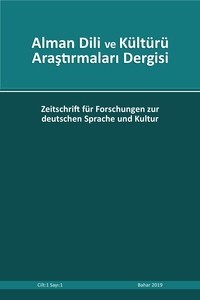Türkçe ve Almanca Karikatürlerde Ünlemler: Dilbilimsel Bir İnceleme
Ünlemlerin dilsel bütünlük içindeki yerleri nedir, ünlemler nasıl anlam kazanırlar, Almanca ve Türkçede ortak ya da farklı özellikleri nelerdir gibi sorulardan yola çıkılarak; çalışmada, Almanca ve Türkçe karikatürlerde ünlem bildiren ifadeler; biçimsel ve anlamsal özellikleri ele alınarak karşılaştırılmıştır. Ünlemler, daha çok konuşma dilinde kullanılan ve anlamlarını genellikle kullanıldıkları bağlama göre kazanan dilsel öğelerdirler. Karikatürler ise sahip oldukları görsel ve metinsel boyutlar sayesinde bir göstergenin anlam kazanmasını sağlayan bağlamın tespit edilebileceği en uygun basılı iletişim araçları arasındadırlar. Bu özellikleri dolayısıyla ünlemler ve karikatürler çalışmada ele alınan temel inceleme konularını oluşturmaktadırlar. Söz konusu inceleme ve ardından yapılacak bir analiz için ünlem bildiren sözcüklerin içinde yer aldığı Almanca ve Türkçe karikatür çiftleri; ünlem sözcüğünün bildirdiği sevinç, üzüntü, tiksinme, şaşkınlık, talep etme gibi duygu ve özelliklerine göre, durumsal olarak eşleştirilerek karşılaştırılmıştır. Dilbilimsel teorik açıklamaların ardından yapılan uygulamalı karşılaştırmada her iki dile ait seçilmiş karikatürler ve içlerinde geçen ünlemler göstergebilimsel, anlambilimsel ve edimbilimsel açılardan incelenmiş, oluşturulan tablolar yardımı ile analiz edilmiş ve yorumlanmıştır. Araştırma sonucunda resim metin ilişkisi yönünden Almanca karikatürlerde metin daha çok tümleyicilik ve yedeklik özelliği gösterirken; Türkçe karikatürlerde metinlerin genellikle bağımlılık özelliği gösterdiği saptanmıştır. Türkçe karikatür metinlerinde daha fazla söz sanatı kullanıldığı ve ünlemlerin metindeki anlam ayırt edici ve dilsel işlevi arttırıcı özellikler sergilediği belirlenmiştir.
Anahtar Kelimeler:
Ünlem, Karikatür, Göstergebilim, Anlambilim, Edimbilim
Interjections in Turkish and German Cartoons: A Linguistic Study
For this study, some questions such as what are the places of interjections in linguistic, how do interjections gain meaning, what are their common or different characteristics in German and Turkish have been set out. Interjections are linguistic elements that are used mostly in the spoken language and whose meanings are generally gained in the context in which they are used. And cartoons with their visual and textual dimensions are the most appropriate printed communication tools, because they create the concept which allows a sign to gain its meaning. Because of these features, interjections and cartoons constitute the main study topics discussed in this study. For that discussion and a subsequent analysis German and Turkish cartoon couples containing an interjection were matched and compared. While doing this, the emotions and features of interjections such as joy, sadness, disgust, confusion and demand are taken into account. In the study, the expressions of interjections in German and Turkish cartoons; their formal and semantic features are handled and compared. In the applied comparison made after the linguistic theoretical explanations, the selected cartoons and the interjections in both languages were examined in terms of semiotic, semantic and pragmatic aspects, analyzed and interpreted with the help of the tables. The result of the research shows that, while the texts in German cartoons in terms of picture-text relation, show more complementarity and redundancy; the texts in Turkish cartoons show generally dependence. It was determined that more figure of speech was used in Turkish cartoon texts, and that the interjections exhibited meaning-differentiating and linguistic function enhancing features.
Keywords:
Interjection Cartoon, Caricature, Semiotics, Semantics, Concept,
___
- Er, Mutlu (2015): Eine semiotische Analyse der Kriegsplakate: Solidaritaet, Kriegsanleihe und Symbolismus im zweiten Weltkrieg. Ankara: Hacettpe Üniversitesi Yayınları. Eziler Kıran, Ayşe (2014): Dilbilim, Anlambilim, Edimbilim. Turkish Studies - International Periodical For The Languages, Literature and History of Turkish or Turkic, Sayı 9/6, 719-729. Henne, Helmut (1978): “Gesprächswörter. Für eine Erweiterung der Wortarten.” Interdisziplinäres deutsches Wörterbuch in der Diskussion içinde (42-47), Düsseldorf: Schwann. Hubmann, Sonja (2017): Deutsche Grammatik: Interjektionen. 25.03.2017 tarihinde kişiell web sitesi http://www.sonni.tv/deutsch_grammatik.htm, adresinden alındı. Gedizli, Mehmet (2015): Türkçede Ünlemler ve Temel İşlevi. Uluslararası Sosyal Araştırmalar Dergisi, Cilt: 8 Sayı: 36, 126-134. König, Ekkehard (2012): Zur Standortbestimmung der Kontrastiven Linguistik innerhalb der vergleichenden Sprachwissenschaft. Deutsch im Sprachvergleich. Grammatische Kontraste und Konvergenzen içinde (13-40), Berlin: Institut für Deutsche Sprache. Lehmann, Christian (2016): Begriff der Interjektion. 20/03/2017 tarihinde kişisel web sitesi http://www.christianlehmann.eu/ adresinden alındı. Marhenke, Dietmar (2003): Britischer Humor im interkulturellen Kontext. Doktora Tezi. Braunschweig: Technische Universität Carolo-Wilhelmina. Morris, Charles W. (1973): Zeichen, Sprache und Verhalten. Düsseldorf: Schwann. Narimo, Sabar (2012): A Semiotical Analysis of Political Caricature Collected by Gatot Eko Cahyona. Lisans Bitirme Tezi. Surakarta: Muhammadiyah Surakarta Üniversitesi. Nöth, Winfrid (2000): Handbuch der Semiotik. Stuttgart: Verlag J.B Metzler. Saussure, Ferdinand (2004): Course in General Linguistics. Literary theory, an anthology / edited by Julie Rivkin and Michael Ryan. - 2. Baskı içinde), Padstow, Cornwall: T.J. International, 59-71 Şahin, Sedat (2000): Eine Vergleichende Studie Über die Semiotische Bedeutung der Karikaturen in Deutschen Und Türkischen Zeitungen. Yüksek Lisans Tezi. Ankara: Hacettepe Üniversitesi. Şahin, Sedat (2014): Göstergebilim ve Tarihsel Gelişimi (Semiyotik, Semiyoloji). Ankara: Hacettepe Üniversitesi Yayınları. Vardar, Berke (2007): Açıklamalı Dilbilim Terimleri Sözlüğü. (2. Baskı), İstanbul: Multilingual. Vater, Heinz (2002): Einführung in die Sprachwissenschaft. München: W. Fink Verlag. Volli, Ugo (2002): Semiotik: Eine Einführung in ihre Grundbegriffe. (Aus dem Ital. Von Uwe Petersen), Tübingen-Basel: UTB.
- Yayın Aralığı: Yılda 2 Sayı
- Başlangıç: 2019
- Yayıncı: H. Kazım KALKAN
Sayıdaki Diğer Makaleler
Humor im DaF-Unterricht und humoristische Elemente im Lehrwerk Studio d
Hasan Kazım KALKAN, Çınla ERÇOKLU
Almanya’da Yaşayan 3. Kuşak Türklerde Sık Kullanılan Kod Aktarım Türleri – Bir Söylem Analizi
Die Heimatsuche von Sascha Muhteschem in Zafer Şenocaks Roman “Gefährliche Verwandschaft”
Die Probleme beim Gebrauch von Präpositionalergänzungen im Deutschen und Türkischen
A1 Düzeyindeki Almanca Öğrencilerinin Yazılı Ürünleri Üzerine Bir Hata Analizi
Hartmann von Aue’nin “Der Arme Heinrich” Adlı Eserindeki Ana Motifler
Türkçe ve Almanca Karikatürlerde Ünlemler: Dilbilimsel Bir İnceleme
